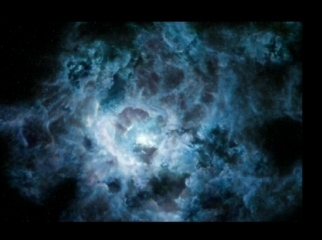|

In Star Trek, the Arachnid Nebula is an interstellar
dust cloud located far from the planet Vulcan. The Arachnid Nebula was
featured on the front cover of "The Cosmos A to Z", an astronomy book
by Laura Danly that claimed the nebula was 6.5 billion kilometers in
diameter. The book which was an inspiration to Captain Jonathan Archer
in his childhood. In 2151, the NX class starship Enterprise and a
Vulcan civilian transport vessel, the Vahklas, completed a survey of
the nebula. The crew of the vessels found that it was actually more
than 8 billion kilometers in diameter, not 6.5 billion. They also noted
over 20 million cubic meters of disodium and traces of ethylchlorate in
the nebula. Enterprise intended to send back the new information to
help revise the astronomy books. (ENT: "Fusion")
In astronomy, there is no actual nebula called the
Arachnid nebula. However, the image used to display the Arachnid nebula
in Star Trek bears a striking resemblance to the Tarantula nebula
(aside from the blue colour used in the Star Trek image). The Tarantula
Nebula (also known as 30 Doradus, or NGC 2070) is an H II region in the
Large Magellanic Cloud. The Tarantula Nebula has an apparent magnitude
of 8. Considering its distance of about 180,000 light years, this is an
extremely luminous object. Its luminosity is so bright that if it were
as close to Earth as the Orion Nebula, the Tarantula Nebula would cast
shadows. In fact, it is the most active starburst region known in the
Local Group of galaxies. It is also the largest and most active such
region in the Local Group with an estimated diameter of 200 parsecs.
The closest supernova since the invention of the telescope, Supernova
1987A, occurred in the outskirts of the Tarantula Nebula.
The tarantula is, of course, classified in biology as an
Arachnid.
|
|
